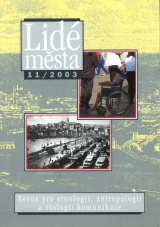Našinci a cizinci
Mentální orientace a kulturní obraz cizinců v pohraničí
DOI:
https://doi.org/10.14712/12128112.4306Abstrakt
The feeling of social identity expresses the need for solidarity and being similar to others. It is determined by the feeling of one's making part of various social groups and categories. The notion "identity" contains the basic duality of meanings. First, it highlights similarity, identity, and it is related to one's being are remaining the same. The second meaning points to the singularity, dissimilarity, difference from others. Identity is associated with "being someone" permanently and in a different way than others, it localises an individual in the world and time, it is a sign of his "roots" and it refers to social identifications. The social space which is perceived as one's own is defined by similarity, the feeling of solidarity and cohesion. In geographical as well as social and cultural terms, the borderland is seen as a divided area. The borderland is defined by the neighborhood of countries, nations and cultures, it is an area of co-existence and permeation, while these processes are based on spatial closeness. Here, the relationship with space has a meaning defining the quality and character of social relations. The border epitomises the historically created or politically enforced division into "our people" and "foreigners", and it reinforces social distance from other communities. We bear witness to the antagonisation of neighborly relations, seclusion in one's own group through a strong accent on one's group identity and the feeling of one's singularity. At the same time, the borderland is a region of a manifold, immediate contact with a different culture. By definition, life in borderland forms a new identity, a new man from the borderland, his social consciousness and cultural identity. The problem of shaping of identity of the man from the borderland was examined by means of a large-scale team research in the Polish-German and Polish-Czech borderland. The study focuses on the question of reflection of others seen by the population of the Polish part of Euroregion Nysa, specifically the images of Germans and Czechs. The research has confirmed that the process of definition of others in cultural terms constitutes a substantial element of biographical self-creations of the borderland population. lt reflects the historically determined relationship to others who live beyond the border. This relationship is subjected to changes under various influences. lt is also influenced by the mental level of those who relate themselves to others. Changes in the mental level come about much slower than the process of creation of a new institutional order. Moreover, social change not only brings about a gradual discovery of new forms of thinking and behaviour, but it also helps preserve old mental patterns, which are a heritage of the past from the Communist, and also the previous era. The stability of mental heritage can be seen in a clash with the new form of institutionalisation of social life and keeps its importance for the quality of new orientations. The mental profile of the population of the Polish part of Euroregion Nysa is conditioned by: anchoring in a family, faith in loyalty and solidarity of others, relationship with one's own society, the attitude to the present-day transformations and relationship to the material capital. The elimination of prejudices and stereotypes, growth in mutual interest and shaping of new forms of cross-border contacts between cultures is not a simple derivative of institutional solutions. The success of the latter depends both on the orientation and intensity of structural changes of the neighbouring communities, and the historically formed mental orientations of its members. In the light of the conducted analysis, one has to state that differences and similarities in mentality can turn out to be the key to establishing directions and opportunities for the development of human contacts in the future.
Stahování
Publikováno
Jak citovat
Číslo
Sekce
Licence

Tato práce je licencována pod Mezinárodní licencí Creative Commons Attribution-NonCommercial-NoDerivatives 4.0.


